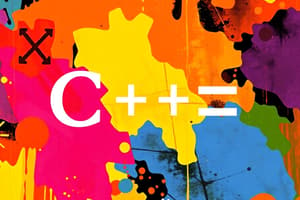Podcast
Questions and Answers
What is the primary purpose of using namespaces in C++?
What is the primary purpose of using namespaces in C++?
- To enable multiple inheritance
- To enhance program performance
- To simplify variable declarations
- To avoid naming collisions (correct)
Which of the following commands must be used to access the standard output stream in the std namespace?
Which of the following commands must be used to access the standard output stream in the std namespace?
- cout
- output::cout
- std::output
- std::cout (correct)
What is the effect of using #include <iostream> in a C++ program?
What is the effect of using #include <iostream> in a C++ program?
- It allows using standard input and output commands (correct)
- It defines custom namespaces
- It imports the math functions
- It optimizes the program for speed
In the context of namespaces, what analogy is used to describe a namespace?
In the context of namespaces, what analogy is used to describe a namespace?
Which of the following statements is true about the std namespace?
Which of the following statements is true about the std namespace?
What does the statement char endl = ' '; achieve within the std namespace?
What does the statement char endl = ' '; achieve within the std namespace?
What feature does the use of ofstream and ifstream in the std namespace provide?
What feature does the use of ofstream and ifstream in the std namespace provide?
Which C++ statement correctly accesses and prints a message using standard output?
Which C++ statement correctly accesses and prints a message using standard output?
What is the purpose of using a namespace in C++?
What is the purpose of using a namespace in C++?
What does the statement 'std::cout' imply?
What does the statement 'std::cout' imply?
In which scenario can two functions with the same name exist without causing a conflict?
In which scenario can two functions with the same name exist without causing a conflict?
What role does the preprocessor directive '#include' serve in the context of namespaces?
What role does the preprocessor directive '#include' serve in the context of namespaces?
What is likely the result of omitting 'std::' before cout when the std namespace is used?
What is likely the result of omitting 'std::' before cout when the std namespace is used?
Study Notes
Learning Outcomes
- Ability to write C++ programs that incorporate namespaces, variables, sequence, selection, and repetition.
- Proficiency in using input commands and formatting output in C++.
The std Namespace
- The
iostream.hheader file contains commands for input and output operations, defined within thestdnamespace. - To use elements like
coutandcinoutside of the namespace, the syntaxstd::cout,std::cin, andstd::endlis required. - The
char endl = '\n';specification signifies the end of a line in C++ output.
Purpose of Namespaces
- Namespaces prevent naming collisions—allowing different sections of code to use the same identifier without conflict.
- Each namespace can be thought of as a separate "folder"; for example, the folder
FOCSLIITcan contain its own variables and functions independently from another folderGraphics. - Examples of distinct functions within different namespaces:
FOCSLIIT::graphics(10,20);Graphics::graphics(10,20);
Implementing Namespaces
- When using the
stdnamespace, it's important to declareusing namespace std;at the beginning of the program to avoid prefixing withstd::. - Each namespace can encapsulate functions and variables, allowing for clear organization and prevention of naming conflicts across multiple code files (e.g.,
namespace1.cppandnamespace2.cpp).
Summary of C++ Program Structure
- An example program starts with
#include <iostream>followed byusing namespace std;. - The
mainfunction serves as the program's entry point, where input/output operations are processed using the designated namespace.
Studying That Suits You
Use AI to generate personalized quizzes and flashcards to suit your learning preferences.
Related Documents
Description
This quiz covers the key concepts of Object Oriented Programming in C++ as discussed in Lecture 02. Students will learn to implement namespaces, variables, and the basic constructs of sequence, selection, and repetition in their C++ programs. Prepare to demonstrate your understanding of input commands and formatting output effectively.




